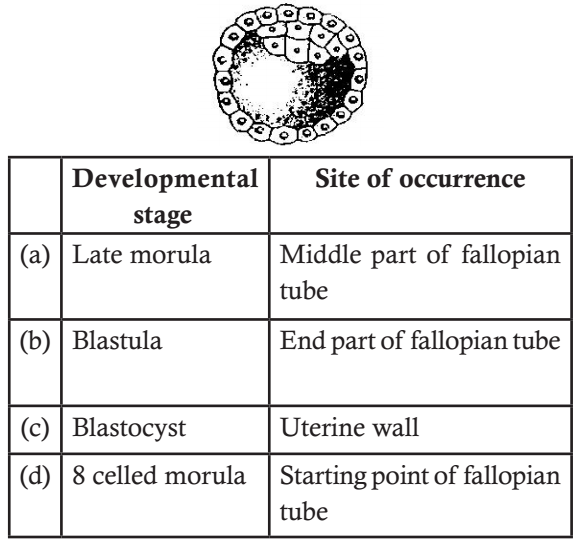Human Reproduction
- Which one of the following is not the function of placenta?
-
View Hint View Answer Discuss in Forum
Function of placenta – The placenta facilitate the supply of oxygen and nutrients to the embryo and also removal of carbon dioxide and excretory/waste materials produced by the embryo. The placenta is connected to the embryo through an umbilical cord which helps in the transport of substances to and from the embryo. Placenta also acts as an endocrine tissue and produces several hormones like human chorionic gonadotropin (hCG), human placental lactogen (hPL), estrogens, progesterone etc.
Correct Option: C
Function of placenta – The placenta facilitate the supply of oxygen and nutrients to the embryo and also removal of carbon dioxide and excretory/waste materials produced by the embryo. The placenta is connected to the embryo through an umbilical cord which helps in the transport of substances to and from the embryo. Placenta also acts as an endocrine tissue and produces several hormones like human chorionic gonadotropin (hCG), human placental lactogen (hPL), estrogens, progesterone etc.
- The foetal ejection reflex in humans triggers release of
-
View Hint View Answer Discuss in Forum
Parturition is induced by a complex neuroendocrine mechanism. The signals for parturition originate from the fully developed foetus and the placenta which induce mild uterine contractions called foetal ejection reflex. This triggers release of oxytocin from the maternal pituitary.
Correct Option: A
Parturition is induced by a complex neuroendocrine mechanism. The signals for parturition originate from the fully developed foetus and the placenta which induce mild uterine contractions called foetal ejection reflex. This triggers release of oxytocin from the maternal pituitary.
- Signals for parturition originate from:
-
View Hint View Answer Discuss in Forum
The signals for child birth (parturition) originate from the fully matured foetus and placenta which induce mild uterine contractions called foetal ejection reflex.
Correct Option: A
The signals for child birth (parturition) originate from the fully matured foetus and placenta which induce mild uterine contractions called foetal ejection reflex.
- Identify the human developmental stage shown below as well as the related right place of its occurrence in a normal pregnant woman, and select the right option for the two together.

-
View Hint View Answer Discuss in Forum
Blastocyst is a thin-walled hollow structure in early embryonic development that contains a cluster of cells called the inner cell mass from which the embryo arises. The outer layer of cells gives rise to the placenta and other supporting tissues needed for fetal development within the uterus while the inner cell mass cells give rise to the tissues of the body. The blastocyst reaches the womb (uterus) around day 5, and implants into the uterine wall on about day 6.
Correct Option: C
Blastocyst is a thin-walled hollow structure in early embryonic development that contains a cluster of cells called the inner cell mass from which the embryo arises. The outer layer of cells gives rise to the placenta and other supporting tissues needed for fetal development within the uterus while the inner cell mass cells give rise to the tissues of the body. The blastocyst reaches the womb (uterus) around day 5, and implants into the uterine wall on about day 6.
- In vitro fertilisation is a technique that involves transfer of which one of the following into the fallopian tube?
-
View Hint View Answer Discuss in Forum
In vitro fertilization is a process where fertilization of egg occurs outside the mother’s womb. This method is used as a major treatment for infertility. This method involves the removal of eggs from the female ovaries. This egg is then allowed to fertilize with sperm in a fluid medium in a test tube. The zygote is allowed to develop for a week. Either zygote or early embryo up to 8 blastomeres is then transferred into the fallopian tube to complete its further development. If the embryo is with more than 8 blastomeres, it is transferred
into uterus for successful pregnancy. A baby conceived by fertilization that occurs outside mother body is called test tube baby.Correct Option: A
In vitro fertilization is a process where fertilization of egg occurs outside the mother’s womb. This method is used as a major treatment for infertility. This method involves the removal of eggs from the female ovaries. This egg is then allowed to fertilize with sperm in a fluid medium in a test tube. The zygote is allowed to develop for a week. Either zygote or early embryo up to 8 blastomeres is then transferred into the fallopian tube to complete its further development. If the embryo is with more than 8 blastomeres, it is transferred
into uterus for successful pregnancy. A baby conceived by fertilization that occurs outside mother body is called test tube baby.

